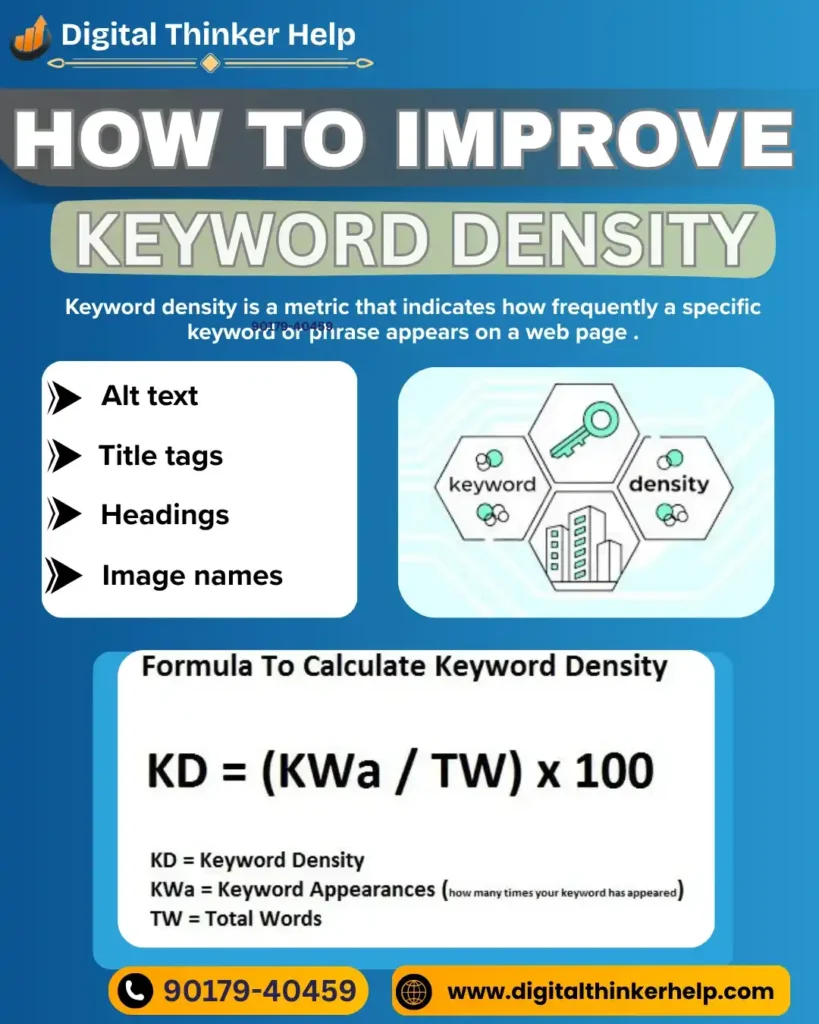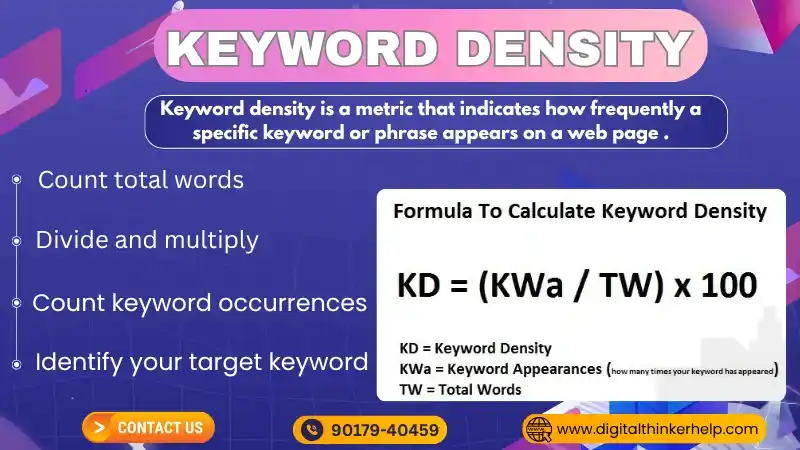Keyword density in SEO means how often a keyword appears in a piece of writing in relation to the total number of words.
It’s often show as a percentage. To find it, divide the number of keywords on the page by the total words on the page, and then multiply by 100.

Here, we will show you with example, when main keyword will be using 10 times in a 1000-word article, then keyword density will be 1%. If you try to use it 30 times, the keyword density will be 3%.
What is Keyword Density in SEO?
Keyword density is how often a specific phrase shows up in your writing. In the past, SEOs focused on it too much, leading to articles filled with keywords that were hard to read.
So, thankful, search engines are better now.
They now focus more attention to the context and instead of just repeating keywords. This means that having a lot of keywords isn’t as important before, but it still matters a bit. It can still show that your content is relevant, and new tools can help you to check how properly you’re doing this.
Let’s explain why keyword density is still important (a bit), how to measure it, and how to find the right balance in between SEO and easy reading.
Keyword Density Formula
You can calculate keyword density as a number if you want. To find the keyword density of a webpage, just divide how many times a keyword is used by the total number of words on the page. This number is the keyword density for that page.
What Is TF-IDF?
TF-IDF, which means ‘term frequency and inverse document frequency,’ is a better method for measuring how often a word appears in a text.
This measure helps find out how important a word is in a document. Search engines might use different versions of TF-IDF to see how relevant a page’s content is to what a user is searching for. But, there are many other SEO factors to consider too.
Why Keyword Density Is Important?
Keyword density was a significant factor in search engine optimization (SEO) for several reasons. However, over time its important has diminished. Here are some historical reasons why keyword density was important in the past:
Search Engine Ranking Algorithms: In the past, search engines used simpler methods, and keyword density was a key measure to find out what a webpage was about and how relevant it was. Pages with more keywords were usually seen as more relevant for certain searches.
Content Relevance: Keyword density showed how well the content matched what a user was searching for. More keywords meant the content was probably closer to what the user wanted.
Content Optimization: Website owners and SEO experts thought that by placing keywords carefully in their content, they could help their pages rank better for those keywords. This resulted in a method called keyword stuffing; where too many keywords were added to the content to try to trick search engines.
Keyword Density vs. Keyword Stuffing
Keyword density suggests how often to use a keyword naturally, while keyword stuffing means adding keywords to a webpage in a way that feels forced.
This is a useless SEO trick that tries to change search results. It helps a webpage show up for many keywords at the same time, but gives no real value.
In the early day of SEO, adding many keywords to a page work well. This was because search algorithms were are not smart now. Just adding lots of keywords was enough to get a good ranking.
After Google updated its Penguin algorithm, using too many keywords stopped working.
Today, using this bad SEO method goes against Google’s spam rules. Doing this could result in penalties, making your website completely vanish from search results.
Can You Rank Without a Specific Keyword Density?
Yes! You can achieve it. You should still pay attention to keywords, but the algorithm works differently now.

In 2025, Google uses smart search to see how well you answer a question. Its system doesn’t see just your exact words; instead of, this also considers ideas, phrases, and how they relate to each other to easily understand meaning.
Semantic search is more than just checking keywords. It considers what the person is trying to find, the tone, feelings, and other factors to get the best answer to a search question.
You should still use keywords, but make sure they flow well in the text and cover the topic fully.
In simple terms, it’s more important to meet what people are looking for and provide what they need. Keywords should fit naturally into the text, not be the main goal.
Keyword Density Best Practices?
Here are some main guidelines for keyword density when you write your web content:
Never Aim for a Set Keyword Density
Keyword density is an old way to check how relevant something is, so there’s no keyword density that is better than others. The important thing should be getting focus on the topic of the piece of content.
Concentrate on Topic Coverage & Depth Instead
Instead of worrying about keyword density, pay attention to how well you covered your topic in your content piece. Deep researched in longer articles can help to explore a topic in more detail than shorter ones that usually leads to more backlinks get higher position in search engine rankings.
Include Keywords in the Main Areas
In the end, we are not telling you to stop using keywords in your content, but make sure they are included in these important areas: the page title (even if it’s not exact), the meta description, the H1 heading, and the page URL. This helps readers quickly see how relevant the page is in search results.
How to Improve Keyword Density?
As we said, keyword density isn’t something you should focus on too much importance on. Don’t worry! Here, you will get to know some essential things that help to improve your keyword density score without compromising the quality of your content.
Besides using your main keyword naturally in your content; you can also add it to these page elements to improve your score:
Title Tag: Put your main keyword in your page title, close to the start for better SEO results.
Headings: Use your main keyword and similar words in H1, H2, and H3 tags to highlight these terms more than other text.
Image Names and Alt Text: Use your main keyword in the image name and in the alt text to boost visibility while keeping it easy to read.
Keyword Density Tools & Calculators
Now we hope that you knew how to use keywords well, how do you check keyword density? Counting and calculating keywords by hand can take a lot of time. Instead, you can use tools that check keyword density, making it easier and helping your content become better for search engines.
Here are best tools of available:
Infidigit Keyword Density Checker Tool – This tool checks how often keywords are used in your content to ensure they’re used.
SEO Review Tools Keyword Density Checker – Put in your URL or text, and this tool will give you a detailed report on keyword density.
SEOBook Keyword Density Analyzer – A free tool that checks how often keywords appear and compares them with competitor pages.
Alexa’s On-Page SEO Checker – This tool helps you see if your keyword use matches good SEO practices for live pages.
FAQs (Frequently Asked Questions)
Should We Use Keyword Variations?
When writing your original content, use different forms of your main and secondary keywords naturally. If you’re unsure, do additional keywords research to find out what terms, phrases, and questions your audience is looking for. This way, you can include the most relevant keyword variations on your page.
What is The Best Keyword Density Means Frequency?
The quick answer is; it depends. There isn’t a best keyword density that works for all search engines and types of content. Each search engine uses a different algorithm and the ideal density can change based on the different topic content. Generally, a density below 3% is good for most uses. We recommend writing in a natural way and using keywords naturally.
How Do You Calculate Keyword Density with Example?
Keyword density is found using this formula:
(How many times the keyword shows up ÷ Total word count) × 100.
For example, if a keyword occurs 10 times in a 1,000-word post, the keyword density is 1%.
Bottom Lines: Keyword Density
Keyword density in SEO is important for good keyword optimization, but finding the right balance is key. Using too many keywords can arise the keyword stuffing problem, but using in little can hurt your SEO efforts. To get the best keyword density, concentrate on natural placement, keeping the topic relevant, and engaging the reader.
Using many tools like Keyword Density Checker can helps check if keywords are used properly in your keyword distribution? Also, using our professional SEO services can improve your keyword strategy, boost your search rankings, and make your content better for visibility in searches.
